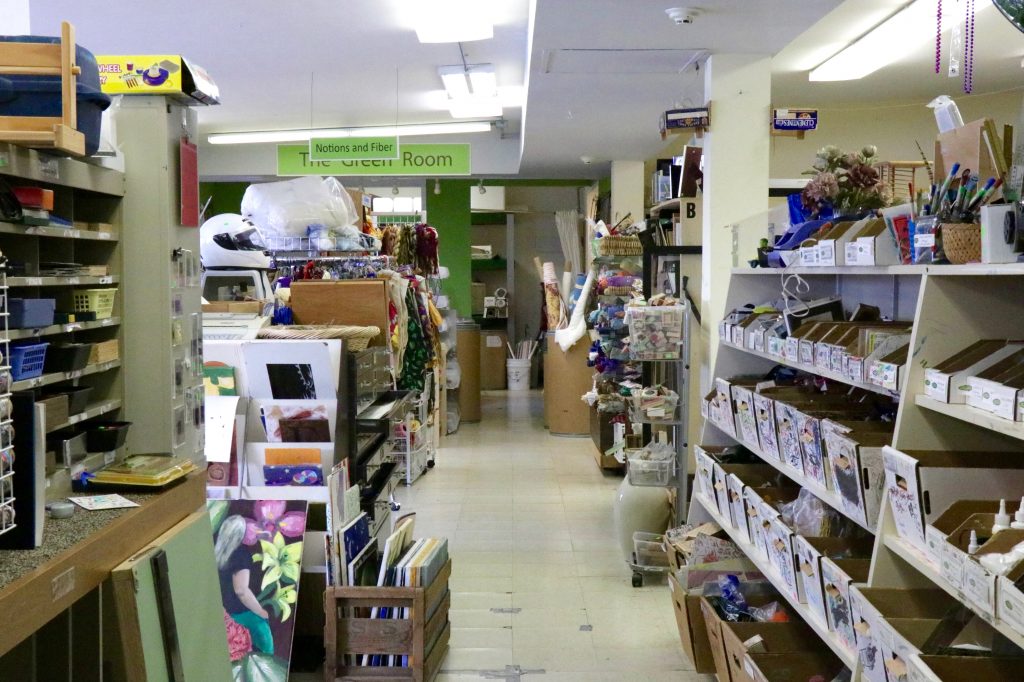It’s payday. You get off work, head over to your favorite store at the mall or your favorite online retailer, and use your latest check to overindulge in some retail therapy. You spend hours poring over shelves and racks (or web pages), considering styles and looking for the perfect bargain in your size. It’s extremely easy to get caught up in the excitement of the hunt for that perfect outfit. When you find it, the rush you get (especially when it’s a financial steal) is part of the appeal. You’re thinking about when and where you’re going to wear it, rather than the environmental implications of its production, purchase, and disposal.
It’s easy to see that the how of clothing production is less well understood and publicized than the marketing of the clothes themselves. Fashion retailers want you to find that consumer high and spend your money, not think about how the clothes are made or what happens to them when they go out of style.
Some people would classify that as a blissful ignorance, but I think it has more to do with a general lack of mainstream media promotion of sustainable fashion as a real, attainable thing. How are people supposed to know about something they’ve never heard of? On the surface, sustainability and fashion are two completely unrelated things, so it’s not surprising that people don’t see how production and consumption influence one another. But the relationship between these two are very much intertwined. It’s important for the public to start taking note.

Photo Courtesy of GreenEarth Cleaning
Fast Fashion
The issue with the fashion industry as a whole, specifically regarding environmental sustainability, is its determination to keep up with quickly changing trends. The average shopper buys much more clothing than did a few decades ago, but keep items half as long. They want trendy, stylish clothing in an accessible location at a reasonable price and they want it NOW. Fast fashion refers to the production of clothing at high speed and low cost to meet increasingly impatient consumer demand. Fast fashion companies are most concerned with lowering costs and getting the product from design to shop floor as quickly as possible. While fast fashion is economically attractive to retailers, the fast-paced production expectations have an enormous environmental impact.
According to the United Nations Economic Commission of Europe, the fashion industry is responsible for producing 20% of global wastewater and 10% of global carbon emissions. That’s more than the emissions of international flights and maritime shipping combined. Creating vibrant and colorful textiles is a critical part of the industry, yet the toxic chemicals associated with textile dyeing are the second largest polluter of clean water globally. Fast fashion has also led to oceans getting bombarded with over a half million tons of plastic microfibers per year due to the washing of plastic-based textiles (polyester, nylon, or acrylic). Textile waste may be an unintended consequence of fast fashion, but that doesn’t mean the industry shouldn’t be held accountable. The problem has now reached a global level. Wardrobes in developed nations are oversaturated. Retailers want to sell as many products as possible and to do that they must stay ahead of the curve, convincing shoppers that their brand is a “must-have” and the items already in their closet are no longer fashionable.
Sustainability and Fashion
While eco-friendly fashion is a trend on the rise, no environmental organization had decided on a concrete definition for what sustainable fashion truly means and stands for. The Ellen Macarthur Foundation recently published a report titled, A New Textiles Economy: Redesigning Fashion’s Future, which establishes sustainability goals for the fashion industry. This report includes four recommendations:
Phase out substances of concern and microfibre release
A. Align industry efforts and coordinate innovation to create safe material cycles.
B. Drastically reduce plastic microfibre release
Transform the way clothes are designed, sold, and used to break free from their increasingly disposable nature
A. Scale-up short-term clothing rental
B. Make durability more attractive
C. Increase clothing utilization further through brand commitments and policy
Radically improve recycling by transforming clothing design, collection, and reprocessing
A. Align clothing design and recycling processes
B. Pursue technological innovation to improve the economics and quality of recycling.
C. Stimulate demand for recycled materials.
D. Implement clothing collection at scale.
Make effective use of resources and move to renewable inputs
The report was written in consultation with many major fashion design companies. Its underlying message is that fashion that should be produced and sold in the most eco-friendly way possible during all stages of production, including design, raw material production, manufacturing, transport, storage, marketing, and final sale. Sustainable fashion can be achieved by ensuring efficient and careful use of natural resources, selecting renewable energy sources (wind, solar, etc.) at every stage, and maximizing repair, remake reuse, and recycling of the product and its components. It even uses sustainability storytelling by highlighting how environmentally conscious fashion can significantly lower costs to businesses and create positive long-term customer relationships.
Ideally, the rules of A New Textiles Economy would be incorporated into every fashion and lifestyle brand’s business model and production processes. Some companies have done so, but there is more work to be done. These standards help raise awareness of sustainability practices, as well as show manufacturers that considering the environment doesn’t have to be expensive or overly complicated.
 Photo Courtesy of Fashionista
Photo Courtesy of Fashionista
Sustainable Brands
So with A New Textile Economy’s standards in mind, here are some examples of companies that are incorporating sustainability into their brands.
- Organic by John Patrick created the world’s first organic oxford cotton shirt and uses other eco-friendly materials such as vegetable-tanned leather, organic wool, and recycled cotton.
- People Tree, partners with Fair Trade artisans and farmers to produce a wide collection of ethical and eco-wear for over 20 years.
- Patagonia’s mission statement incorporates sustainability by making quality products that can be repaired, supporting grassroots activists by paying an Earth Tax, and supporting regenerative practices in ranching and agriculture.
- Adidas partners with Parley Plastics to incorporate plastics recovered from the ocean in their shoes, clothing, and plastic hangers. On some of their product lines, they’ve also debuted ZeroDye, which features undyed polyester. Finally, they’re partnering with Fashion for Good to green the apparel supply chain. Read more about Adidas’ sustainability initiatives here.
- Nike incorporates recycled polyester into 75% of their shoes and apparel. The dye process used for soles in the Nike Air line allows 99% of recoverable dye water to be recycled. All Air sole innovations designed since 2008 are composed of at least 50% recycled manufacturing waste. Nike also transforms used product into Nike Grind, which is created from recycled athletic footwear and surplus manufacturing scraps to make performance products, ranging from new footwear and apparel to sports surfaces. Read more about Nike’s sustainability efforts here.
- H&M’s new Paris flagship store includes an entire floor dedicated to clothing repair. It includes a fleet of sewing machines, bottles of natural detergents, and eco-friendly stain removing sprays, along with bins of patches and embroideries. The idea is to invite customers to bring in clothing, both H&M and other brands, to be repaired and made new again. Customers can restyle their old clothing to update and upcycle their looks. The floor also includes a recycling station where customers can recycled their old clothes (not just H&M) in exchange for a store discount.

Photo Courtesy of Patagonia
For more info on sustainable brands visit http://www.thegoodtrade.com/features/fair-trade-clothing and https://www.marieclaire.com/fashion/a22237305/sustainable-closet-guide/.
The Bottom Line
Turning the fashion industry into something noticeably more sustainable won’t happen overnight. Some brands will continue to pursue short-term economic gains over longer-term environmental costs. That’s why it’s so important for consumers to understand the impact of their choices on the industry. Fast fashion is preventable. If we take a second to slow down and pay attention to how much our desire for the latest styles at the lowest prices encourages companies to cut environmental corners, real progress can happen. The more we become informed about these issues and use that information to change our daily routines, the more the fashion industry will be pressured to think more sustainably. Next time it’s payday and you go on your shopping binge, shop with a conscience. Or don’t shop at all.




 Photo Courtesy of Fashionista
Photo Courtesy of Fashionista 



 The IDEA Store won’t be located at its current Springfield Avenue location for much longer. Morgan and team are in the process of transitioning the store to a new location at Lincoln Square Mall in Urbana. To accommodate an exponential growth in donations, the Lincoln Square storefront will be three times larger than the current location. This will allow excess items currently stored in the warehouses to be sold on the floor. The location also makes it much easier to donate materials. Instead of having to physically bring their donations in and hand them off to volunteers, customers will be able to drive around to the back of the mall and simply ring the doorbell to have their items collected. Keep an eye out for the new store, which has a targeted opening date of late October.
The IDEA Store won’t be located at its current Springfield Avenue location for much longer. Morgan and team are in the process of transitioning the store to a new location at Lincoln Square Mall in Urbana. To accommodate an exponential growth in donations, the Lincoln Square storefront will be three times larger than the current location. This will allow excess items currently stored in the warehouses to be sold on the floor. The location also makes it much easier to donate materials. Instead of having to physically bring their donations in and hand them off to volunteers, customers will be able to drive around to the back of the mall and simply ring the doorbell to have their items collected. Keep an eye out for the new store, which has a targeted opening date of late October. 


